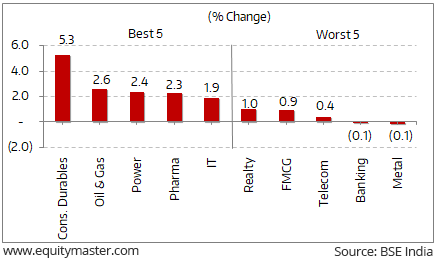Global financial markets ended the week on a positive note. Except the Chinese financial markets, all global indices registered gains over the week. In the US, the Dow industrials ended the week up 0.9%. The US indices edged up over a favorable holiday season with the S&P 500 and Nasdaq Composite indices hitting record highs over the week. The US Federal Reserve officials expressed largely optimistic views of economic growth at their most recent meeting but also started to worry that financial market prices are getting out of hand and posing a danger to the economy. From the minutes of the Fed’s latest meet, majority of the members were in the favour of a rate hike in the near term.
European equities ended the week higher as they digested minutes of the European Central Bank’s latest meeting. Europe’s major indexes began the week in the red, however ended the week strong on the back of positive manufacturing and jobs data coming in from France and Germany. French and German markets were up by 1.3% and 0.5% respectively this week, while UK’s indices were up by 0.4% over the week.
Chinese stocks declined for the week, after the country’s blue-chip index suffered its biggest one-day fall in 17 months.
Key World Markets During the Week

Back home, benchmark indices in India were on an uptrend throughout the week, and ended the week on a positive note. A rally by IT stocks helped the BSE Sensex gain 1% over the week.
BSE Indices During the Week

Now let us discuss some key economic and industry developments during the week gone by
Days after upgrading India’s sovereign rating to Baa2 from Baa3 with a stable outlook, global credit rating agency Moody’s Investors Services in its latest report has stated that Indian companies will see an improvement in its credit profile in the year 2018.
The report notes the companies will improve on the back of better sales as it expects Goods and Services Tax (GST)-related activity disruption to diminish, leading to an all over recovery in economic activities.
Besides, it noted that refinancing needs in 2018 would be manageable for most companies, given their improving access to capital markets and their large cash balances. It also said that corporates’ cross-border bond maturities will also be manageable for the next three years.
The rating agency expects that the country’s Gross domestic product (GDP) growth of around 7.6% will result in higher sales volumes, which, along with new production capacities and benign commodity prices, will support an EBITDA (earnings before interest, taxes, depreciation and amortisation) growth of 5-6% over next 12 to 18 months.
Adding further, it said that a further simplification of GST and other structural reforms, or an improvement in commodity prices, resulting in higher operating profit could further improve companies’ credit profiles. Apart from this, it noted that an improvement in asset valuations, providing a means of deleveraging for some corporates will also result in improvement in their credit profiles.
Crisil Ratings in its latest report has said that in India bank credit to the micro, small and medium enterprises (MSME) sector, whose current market size is estimated at around Rs trillion, is likely to expand at 11% compound annual growth rate (CAGR) over the next two financial years. It added that this is way faster than the 7% anticipated growth in bank credit to India Inc.
The rating agency said that over the past five fiscals ending 2017, non-banking finance companies recorded a four-fold increase in their credit book to MSMEs. Consequently, their cumulative market share in MSME financing rose to 18% in fiscal 2017 from 8% five years ago. It added that this will rise to over 20% in two years.
Lenders have been trying to protect their return on assets by focusing on smaller loans, where yields are higher, and on unsecured loans. For NBFCs, unsecured loans account for 20% of the MSME portfolio as of March 2017. However, the report noted that while competition has intensified and asset quality has weakened, the overall opportunity remains compelling, given the huge under-penetration of formal finance in the MSME segment. Moreover, structural changes such as the goods and services tax will increase transparency in MSME financials.
It also said the competitiveness of MSMEs would be determined by the extent of tax avoidance, their position in the value chain, labour cost arbitrage, product offering, local market knowledge and proximity to customer.













Leave A Comment